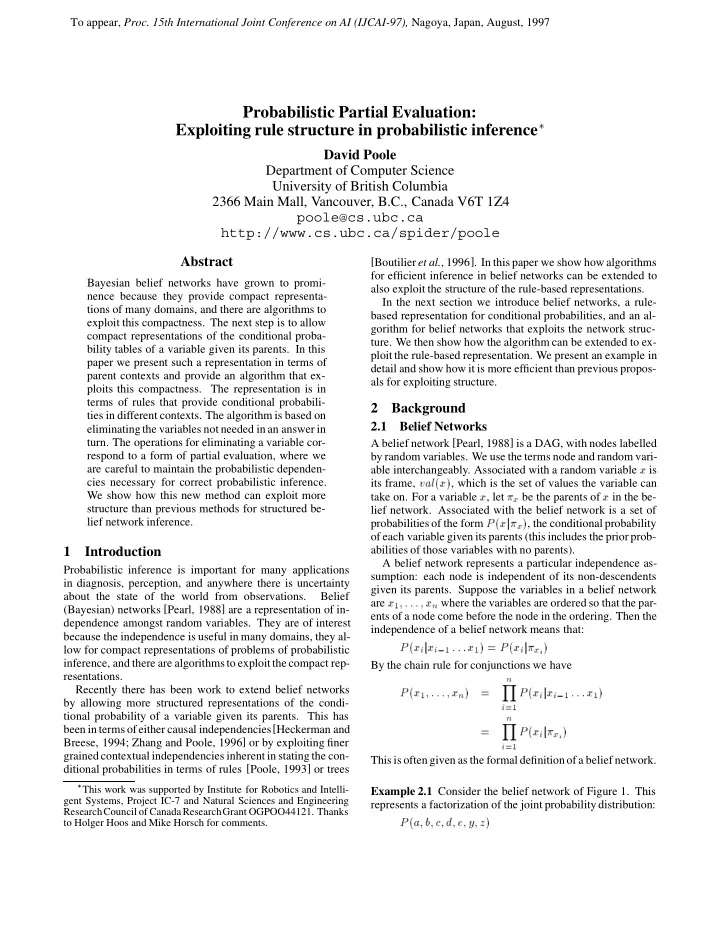

To appear, Proc. 15th International Joint Conference on AI (IJCAI-97), Nagoya, Japan, August, 1997 Probabilistic Partial Evaluation: � Exploiting rule structure in probabilistic inference David Poole Department of Computer Science University of British Columbia 2366 Main Mall, Vancouver, B.C., Canada V6T 1Z4 poole@cs.ubc.ca http://www.cs.ubc.ca/spider/poole Abstract [Boutilier et al. , 1996]. In this paper we show how algorithms for efficient inference in belief networks can be extended to Bayesian belief networks have grown to promi- also exploit the structure of the rule-based representations. nence because they provide compact representa- In the next section we introduce belief networks, a rule- tions of many domains, and there are algorithms to based representation for conditional probabilities, and an al- exploit this compactness. The next step is to allow gorithm for belief networks that exploits the network struc- compact representations of the conditional proba- ture. We then show how the algorithm can be extended to ex- bility tables of a variable given its parents. In this ploit the rule-based representation. We present an example in paper we present such a representation in terms of detail and show how it is more efficient than previous propos- parent contexts and provide an algorithm that ex- als for exploiting structure. ploits this compactness. The representation is in terms of rules that provide conditional probabili- 2 Background ties in different contexts. The algorithm is based on 2.1 Belief Networks eliminatingthe variables not needed in an answer in turn. The operations for eliminating a variable cor- A belief network [Pearl, 1988] is a DAG, with nodes labelled respond to a form of partial evaluation, where we by random variables. We use the terms node and random vari- are careful to maintain the probabilistic dependen- able interchangeably. Associated with a random variable x is cies necessary for correct probabilistic inference. its frame, v al � x � , which is the set of values the variable can We show how this new method can exploit more take on. For a variable x , let � x be the parents of x in the be- structure than previous methods for structured be- lief network. Associated with the belief network is a set of lief network inference. P � x j � � , the conditional probability probabilities of the form x of each variable given its parents (this includes the prior prob- abilities of those variables with no parents). 1 Introduction A belief network represents a particular independence as- Probabilistic inference is important for many applications sumption: each node is independent of its non-descendents in diagnosis, perception, and anywhere there is uncertainty given its parents. Suppose the variables in a belief network about the state of the world from observations. Belief are x � � � � � x n where the variables are ordered so that the par- � (Bayesian) networks [Pearl, 1988] are a representation of in- ents of a node come before the node in the ordering. Then the dependence amongst random variables. They are of interest independence of a belief network means that: because the independence is useful in many domains, they al- � x j x � � � x j � � P � � � x P low for compact representations of problems of probabilistic i i � � � i x i inference, and there are algorithmsto exploitthe compact rep- By the chain rule for conjunctions we have resentations. n Recently there has been work to extend belief networks Y P � x � � � � � x � � P � x j x � � � x � � n i i � � � by allowing more structured representations of the condi- i �� tional probability of a variable given its parents. This has n been in terms ofeither causal independencies[Heckerman and Y � � x j � � P i x i Breese, 1994; Zhang and Poole, 1996] or by exploiting finer i �� grained contextual independencies inherent in stating the con- This is often given as the formal definitionof a belief network. ditional probabilities in terms of rules [Poole, 1993] or trees � This work was supported by Institute for Robotics and Intelli- Example 2.1 Consider the belief network of Figure 1. This gent Systems, Project IC-7 and Natural Sciences and Engineering represents a factorization of the joint probability distribution: ResearchCouncil of CanadaResearchGrant OGPOO44121. Thanks � a� � to Holger Hoos and Mike Horsch for comments. P b� c� d� e� y � z
Recommend
More recommend